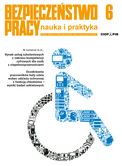What the quality of life of people with physical disability depends on
Karolina Pawłowska-Cyprysiak
Literature and research shows that the quality of life of people with physical disability depends on factors like gender, age and occupational activity. Results of a study conducted on 426 people with physical disability (age 18-65) indicate that people with physical disability who work have a much higher quality of life than those who do not. Women have a better view of their physical functioning than men. The youngest group has the highest opinion on their quality of life. Considering the results, it is necessary to take action, e.g., training courses or counselling, for people with physical disability to raise their quality of life.
Using genetic algorithms to limit occupational exposure to noise
Leszek Morzyński
This article discusses the possibilities of using genetic algorithms to limit occupational exposure to noise. It introduces the principles of operation and the basic terms used in genetic algorithms. The article describes a genetic algorithm for optimizing the location of noise sources and workstations to minimize workers’ exposure to noise. It also provides an example of a computer application based on the genetic algorithm and its results.
Solar UV and phototoxic chemical substances - occupational risk assessment
Agnieszka Wolska, Małgorzata Pośniak, Małgorzata Szewczyńska
Solar UV and different chemical substances are often present at the same time at outdoor workstations. As a result, they affect workers’ skin and they can induce skin diseases called exogenic photodermatitis. Among occupational groups at such workstations are road construction workers who lay the asphalt. Bitumen mass is a source of phototoxic substances: phenanthrene and anthracene at these workstations. The workers should have appropriate protective measures chosen on the basis of risk assessment. This article presents new criteria and a method of risk assessment related to simultaneous impact of solar UV and chemical substances. The new method is an estimation method based on calculating the index of exposure of skin to UV and chemical substances; it takes into account indexes related to the clouds, clothes, shade and duration of exposure.
A cold environment - its specificity and ways of protecting the human body against the adverse effects of the cold
Anna Marszałek
This article presents the principles of assessing thermal load in a cold environment. It also discusses why different workers require different thermal insulation of protective clothing. Elements that help to maintain thermal balance in a cold environment are listed.
A young worker - a safe start at work
Anna Namysł, Karolina Pawłowska-Cyprysiak, Marzena Malińska, Joanna Bugajska
This article discusses young workers (15-24 years), their situation in the labour market, legal guidelines for employing young persons (16-18) and the issue of health risks faced by young workers at work (especially musculoskeletal load). It also provides examples of good practices in this area.
A behavioral approach to changing attitudes towards safety
Agnieszka Szczygielska
In reference to the earlier publication (“BP” no. 4/2011), which described the behavioral approa ch to changing attitudes towards safety, this article discusses the results of a study by CIOP-0PIB in 2008 and 2010 on a sample of 500 workers of mining, construction and industrial processing. The study included, among others, the use in Polish companies of positive and negative sanctions in order to improve safety. The results of the study showed that a large percentage of employers does not use formally motivate employees to behave safely. It is therefore necessary to encourage, particularly employers representing small businesses, to take such actions. The article also presents an example of negative sanctions used in a medium-sized construction company in relation to employees who violated safety rules.





























